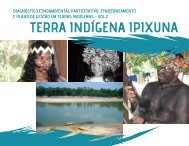IGARAPÉ LOURDES - Kanindé
IGARAPÉ LOURDES - Kanindé
IGARAPÉ LOURDES - Kanindé
Create successful ePaper yourself
Turn your PDF publications into a flip-book with our unique Google optimized e-Paper software.
HAFFER, J. 1990. Avian Species Richness in Tropical South America. Studies on Neotropical Fauna and Environment. 25(3):157-183.<br />
HAFFER, J. 1992. Parapatric species of birds. Bull. B.O.C.. 112(4):250-263.<br />
HELLMAYR, C.E. 1910. The birds of the Rio Madeira. Nov. Zool. 17:257-428.<br />
JOHNS, A. D. 1991. Responses of Amazonian rain forest birds to habitat modification. Journal of Tropical Ecology 7: 417-37.<br />
KARR, J. R., & ROTH, R. R. 1971. Vegetation structure and avian diversity in several New World areas. The American Naturalist, 105:423-35.<br />
MIRANDA-RIBEIRO, A. & SOARES, E.E. 1920. Os psittacideos da “comissão-Rondon”. Com. Linhas Telegraph. Estratégicas Matto-Grosso ao<br />
Amazonas, publ. 63, Anexo 5, pp.6-14.<br />
MÜLLER, P. 1973. The dispersal centers of terrestrial vertebrates in the Neotropical Realm. W. Junk. The Hague. Netherlands.<br />
PELZELN, A. 1868-1870. Zur Ornithologie Brasiliens. Resultate von Johann Natterers Reisen in den Jahran 1817 bis 1835. Druck und Verlag von<br />
A. Pichler’s Witwe & Sohn , Vienna, Austria.<br />
PRANCE, G.T. 1973. Phytogeographic support for the theory of Pleistocene forest refuges in the Amazon basin, based on evidence from distribution<br />
patterns in Caryocaraceae, Chrysobalanaceae, Dichapetalaceae and Lecythidaceae. Acta Amazonica 3:5-28.<br />
ROTH, P. 1984. Repartição do hábitat entre psitacídeos simpátricos no sul da Amazônia. Acta Amazônica, 14 (1-2): 175-221.<br />
STOTZ. D. F.; FITZPATRICK, J. W.; PARKER III, T. A. ; MOSKOVITS, D. K. 1996. Neotropical birds: ecology and conservation. Chicago, University<br />
of Chicago Press. 478p.<br />
STOTZ, D.F.; LANYON, S.M.; SCHULENBERG, T.S.; WILLARD, D.E.; PETERSON, A.T. & FITZPATRICK, J.W. 1997. An avifaunal survey of two<br />
tropicaç forest localities on the middle Rio Jiparaná, Rondônia, Brazil. Ornithological Monographs 48:763-781.<br />
TERBORGH, J. W.; DEMASTER, J. W. & EMMONS, L. 1984. Annotated checklist of birds and mammal species of Cocha Cashu Biological Station,<br />
Manu National Park, Peru. Fieldiana (Zoology) 21: 1-29.<br />
THIOLLAY, J. M. 1992. Influence of selective logging on bird species diversity in a guianian rain forests. Conservation Biology, 6 (1): 47-63.<br />
WILLIS, E. O. & ONIKI, Y. 1992. As aves e as formigas de correição. Bol. Mus. Para. Emílio Goeldi, sér. Zool. 8 (1): 123-50.<br />
RÉPTEIS E ANFIBIOS<br />
ÁVILA-PIRES, T.C.S. Lizards of Brazilian Amazônia (Reptilia: Squamata). Zool. Verh. Leiden 299, 20.iv.1995: 1-706.<br />
BERNARDE, P.S., Kokubum, M.N.C., Machado, R.A., Anjos, L. Uso de habitats naturais e antropicos pelos anuros em uma localidade no Estado<br />
de Rondônia, Brasil (Amphibia: Anura). Acta Amazônica 29(4):555-562. 1999.<br />
CAMPBELL, H. W. & S. P. CHRISTMAN (1982). Field techniques for herpetofaunal community analysis. In: SCOTT, N. J., JR. (ed.): Herpetological<br />
Communities. Wildlife Research Report 13. U.S. Department of the Interior, Fish and Wildlife Service. 13: 193-200.<br />
CUNHA, O. R. e F. P. Nascimento. 1993. Ofídios da Amazônia. As cobras da região leste do Pará. Bol.Mus.Para. Emilio Goeldi, ser. Zool. 9:1 –<br />
191.<br />
DIXON, J. R. 1989. A key and checklist to the Neotropical snakes Genus Liophis with country lists and maps. Smithsonian Herpetological Information<br />
Service 79:1-40.<br />
DUELLMAN, W. E. 1990. Herpetofaunas in Neotropical rainforests: comparative composition, history, and resource use. Pp. 455-505 In: Gentry,<br />
A H. (ed.), Four Neotropical Rainforests. Yale University Press, New Haven.<br />
FROST, D. R. 2000. Amphibian species of the world. Disponível on line em : http://research.amnh.org/herpetology.<br />
MARTINS, M. e M.E. Oliveira. 1998. Natural history of snakes in forests of the Manaus region, Central Amazônia, Brazil. Herpetological Natural<br />
History 6:78-150.<br />
NASCIMENTO, F.P., T.C.S. Ávila-Pires, & O.R. Cunha, 1988. Répteis Squamata de Rondônia e Mato Grosso coletados através do programa Polonoroeste.<br />
Bol. Mus. Para. Emilio Goeldi, Zool., 4(1):21-66.<br />
PETERS, J. A. & OREJAS-MIRANDA, B. 1970. Catalogue of the Neotropical Squamata. Part I. Snakes. Bull. U. S. Natl. Mus. 297:1-347.<br />
SCOTT, N. J. , Jr, R. C. MAXWELL, º W. THORNTON, JR., L. A. FITZGERALD E J. W. FLURY. 1989. Distribution, Habitat and Future of Harter’s<br />
Water Snake, Nerodia harteri, in Texas. J. Herpetol. 23:373-389<br />
SILVA Jr, N.J. The snakes from Samuel Hydroeletric Power plant and vicinity, Rondônia, Brazil. Herpetological Natural History, 1 (1) 1993, pages<br />
37-86.<br />
TOCHER, M. D., C. Gascon, e J. Mayer. 2001. Community composition and breeding success of Amazonian frogs in continuous Forest and matrix<br />
habitat aquatic sites. Yale University Press, New Haven.<br />
VANZOLINI, P. E. 1986. Levantamento herpetológico na área do Estado de Rondônia sob a influência da Rodovia Br 364. Programa Polonoroeste,<br />
CNPq, Relat. Pesq. 1:1-50.<br />
ZIMMER, K. J.; PARKER III, T. A.; ISLER, M. L. & ISLER, P. R. 1997. Survey of a southern Amazonian avifauna: the Alta Floresta region, Mato<br />
Grosso, Brazil. In Studies in Neotropical Ornithology Honoring Ted Parker (J. V. Remsen Jr, Ed.). Ornithol. Monogr. N. 48.<br />
87




